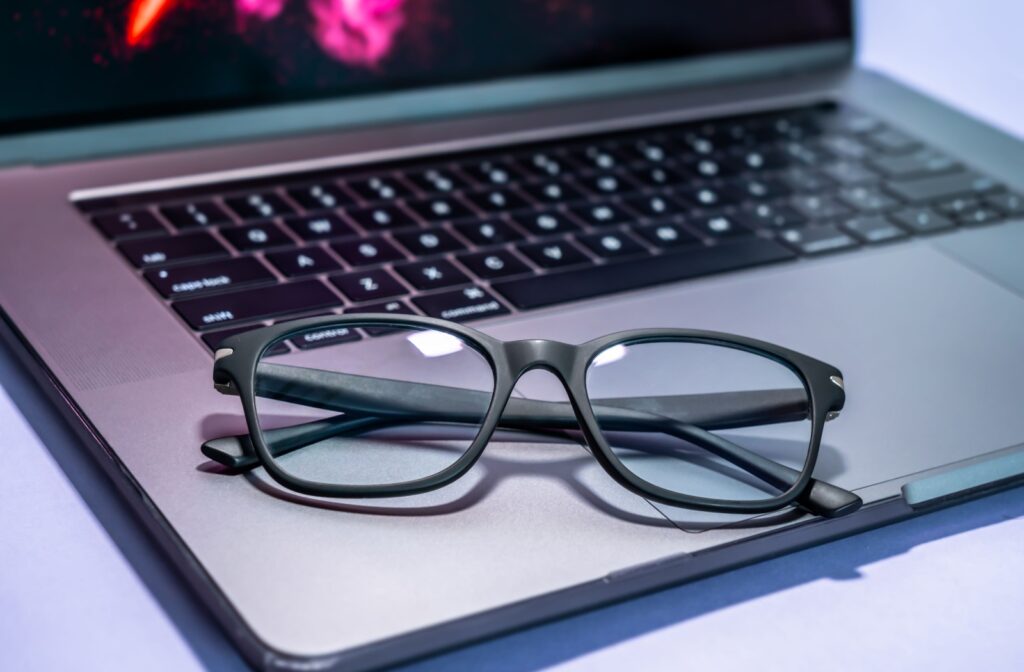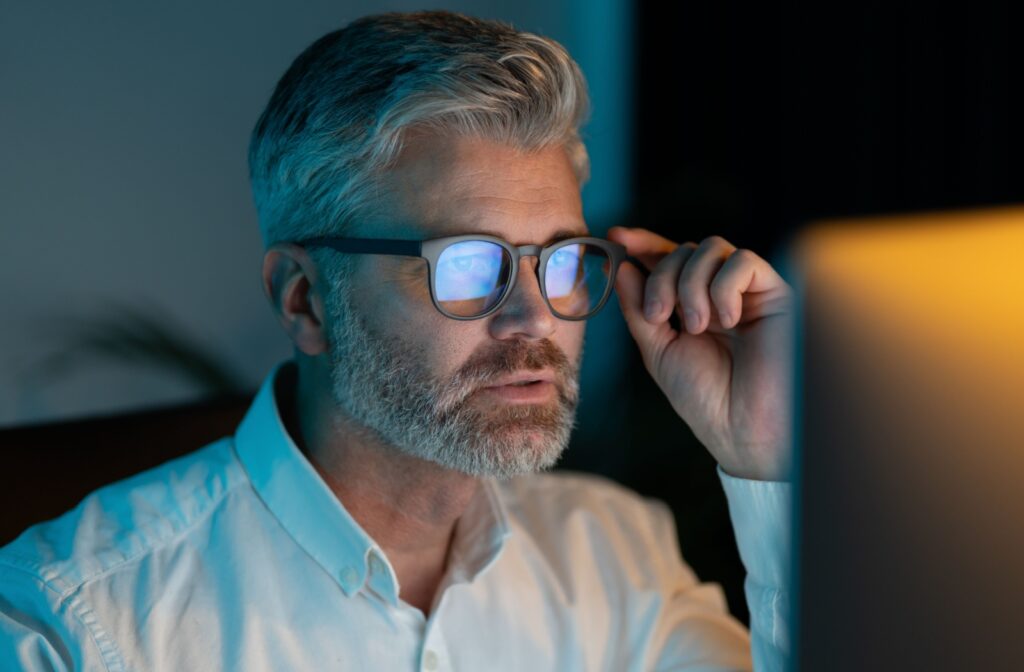In a world full of screens, your eyes work hard all day long. You may have heard about blue light glasses as a way to help ease some of the discomfort of our digital lives, but it’s important to approach eye health holistically. That’s why we emphasize comprehensive eye care to address the root causes of vision issues.
While you can wear blue light glasses all day, it’s not always necessary, as they’re most helpful during long periods of screen use.
What Are Blue Light Glasses?
Blue light glasses may look like many of our other stylish frames, but they serve their own, distinct purpose. They block a portion of the blue light waves you’re exposed to from ever reaching your eyes. This creates a buffer between your vision and the blue light coming from digital screens and artificial lighting.
How They Look & Feel
You might see a slight, warm-colored tint on the lenses of blue light glasses. This is a normal result of the filtering technology. Some people also notice a minor shift in how they perceive colors while they have their glasses on.
Blue Light & Your Eyes
Blue light is a part of the visible light spectrum that contains high energy. The sun is our main source of blue light, but many digital devices and energy-efficient lights also produce it. This consistent exposure from artificial sources is a relatively new part of modern life.
Screen Time & Your Eye Health
Spending a lot of time in front of a screen can lead to a condition known as computer vision syndrome, or digital eye strain. There is no direct correlation that blue light itself causes digital eye strain. Instead, it can be caused by a number of factors, including:
- Decreased blink rate
- Prolonged close-up work
- Poor posture
- Screen glare
- Uncorrected vision problems
Symptoms of Digital Eye Strain
You may experience a few different symptoms associated with digital eye strain, including:
- Tired or sore eyes
- Blurry vision
- Dry or burning eyes
- Headaches
- Stiffness in the neck & shoulders
If you’re experiencing any of the following symptoms, don’t hesitate to reach out to your eye doctor. A comprehensive eye exam can help determine the cause of your strain and provide a tailored treatment plan for relief.

The Debate on All-Day Wear
There are different perspectives on whether you need to wear blue light glasses from morning to night. While it’s generally fine to wear them all day, they aren’t really needed for every situation.
When to Wear Blue Light Glasses
It can be helpful to put on your blue light glasses during specific activities, for instance, when you plan to use a computer, tablet, or phone for a long time. They can also be useful if you spend your day in an office with bright LED lighting.
Are There Disadvantages to Constant Use?
The main drawback that people report is a slight change in their perception of color. Because the lenses filter out some blue light, colors may appear to be a bit warmer while your glasses are on. This usually isn’t a big change, but it’s still something worth keeping in mind.
The Role of Blue Light in Your Health
There’s a lot of conversation about how effective blue light glasses are for daily use. It’s helpful to know that the amount of blue light from screens is very small compared to what you get from natural sunlight. The key is understanding how different types of blue light exposure affect your body.
The Sleep-Wake Cycle Connection
Natural blue light from the sun is important for regulating your body’s internal clock, also known as your circadian rhythm. It sends signals to your brain to be awake and alert during the day.
Exposure to blue light from screens at night may interfere with your body’s ability to produce melatonin, the chemical that helps you sleep.
A Complete Approach to Eye Comfort
Digital eye strain is a complex issue. Factors related to your habits and environment can contribute to the discomfort you feel after a long day of screen time.
Simple Tips to Reduce Eye Discomfort
You can adopt simple good habits to help your eyes feel more comfortable. In fact, small changes can make a noticeable difference in your daily routine.
- Follow the 20-20-20 rule: every 20 minutes, look at something 20 feet away for 20 seconds.
- Adjust your screen so it’s about an arm’s length away and just below eye level.
- Use lubricating eye drops to help with dryness.
- We recommend doing eye exercises designed to help with eye strain.
- Make sure your room has comfortable lighting that doesn’t cause glare on your screen.
The Importance of a Comprehensive Eye Exam
A regular, comprehensive eye exam is a great way to check for underlying issues that might be causing discomfort. Keeping your prescription up to date and confirming that your eyes are healthy are both great ways to be proactive about dealing with eye strain. Talking about your screen time with an eye doctor can also help you find personalized solutions.
Managing your eye comfort in our digital world involves looking at the big picture. At Total Vision Camarillo, we take a detailed look at your eye health to support your vision quality. Schedule a visit to discuss your options and create a plan that fits your lifestyle.



